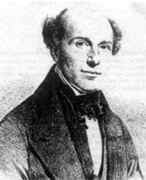Person: Lloyd (2), Humphrey

Humphrey Lloyd was an Irish applied mathematician who worked on conical refraction and geomagnetism.
Mathematical Profile (Excerpt):
- Bartholomew Lloyd was a mathematician and has a biography in this archive.
- Humphrey was a pupil at the Rev William White's School on South Frederick Street, Dublin.
- However, at Trinity College, Lloyd's main subjects were mathematics and physics.
- Bartholomew Lloyd had become professor of mathematics at Trinity in 1813 and, taking over a department in which the teaching had been very old-fashioned with no calculus taught, he had quickly introduced the continental approach to calculus teaching from Lacroix's textbook Traité élémentaire de calcul differéntiel et du calcul intégral, from Poisson's Traité de mécanique, and from Laplace's Mécanique Céleste.
- Humphrey Lloyd was one of the first students to have the advantages of this new up-to-date curriculum and he graduated with a B.A. in 1819 having been placed as the top student of his year and winning the gold medal for science.
- Lloyd continued to study at Trinity College, Dublin, aiming to gain a fellowship.
- Now Lloyd, with a strong background in mathematics and physics, undertook research on optics.
- We can get a good idea of how Lloyd felt about these high teaching loads from the Preface of his book A treatise on light and vision which was published in 1831.
- There is no suggestion that Bartholomew Lloyd made these changes to benefit his own son, but there is no doubt that, given the new arrangements, Humphrey Lloyd was the obvious candidate to fill the Erasmus Smith Chair of Natural and Experimental Philosophy.
- Bartholomew Lloyd tried to argue for an exemption to the rule for the holder of the Erasmus Smith Chair but, as soon as he saw that this would be strongly opposed by others, he dropped the idea and the appointment of Humphrey Lloyd to the Erasmus Smith Chair of Natural and Experimental Philosophy went through.
- Up to 1831 when he was appointed to the chair, Humphrey Lloyd was essentially an applied mathematician.
- The experiment for which Lloyd is best remembered today was carried out about a year after he was appointed to the chair.
- After publishing his paper on 22 October 1832, Hamilton asked Lloyd if he could carry out the necessary experiments to confirm his theoretical prediction.
- After overcoming some initial problems, Lloyd confirmed that he had observed the conical refraction in his February 1833 paper On the phenomena presented by light in its passage along the axes of biaxial crystals.
- Hamilton's theoretical approach was described by Lloyd in his 'Report on the progress and present state of physical optics' which he made to the British Association for the Advancement of Science at its meeting in Edinburgh in 1834.
- It is important to insist upon Lloyd's share in Hamilton's work, because the law of polarization, re-explained by Hamilton in his own language, is found in the latter's memoir supposedly read on October 22, 1832, without reference to Lloyd.
- In the Hilary Term of 1834 Lloyd delivered his Introductory Lecture On the rise and progress of Mechanical Philosophy to the Philosophy School of Trinity College.
- Lloyd's experimental verification of conical refraction of light was powerful evidence for the wave theory of light and the importance attached to his work can be seen from the fact that he was elected a fellow of the Royal Society of London in 1836.
- Lloyd, always good as a mediator, was able to calm the two down and peace was restored when MacCullagh published a further note apologising for his over-reaction.
- Lloyd next turned his attention to the study of the Earth's magnetic field.
- Lloyd had made a magnetic survey of Ireland in 1834 and 1835 and, near the end of the latter year he contacted Gauss starting their correspondence on geo-magnetism.
- The work being carried out in Germany prompted the British Association, together with the Royal Society, to set up a committee in 1838 consisting of John Herschel, William Whewell, George Peacock and Humphrey Lloyd.
- Humphrey Lloyd had taken charge of the observatory and fitted it out with instruments of his own design.
- In 1843 Lloyd became a senior fellow of Trinity College, Dublin and at that time resigned from the Erasmus Smith Chair of Natural and Experimental Philosophy.
- In 1862 Lloyd became vice-Provost of Trinity College, Dublin, then five years later he became Provost, a position he held for 14 years until his death.
- As a fellow of Trinity, Lloyd was required to take holy orders and he received his D.D. in 1840.
- Lloyd played a major role in the disestablished Church of Ireland serving on its General Synod, writing articles on religious doctrine and assisting in a revision of the prayer book.
Born 16 April 1800, Dublin, Ireland. Died 17 January 1881, Dublin, Ireland.
View full biography at MacTutor
Tags relevant for this person:
Origin Ireland
Thank you to the contributors under CC BY-SA 4.0! 

- Github:
-

- non-Github:
- @J-J-O'Connor
- @E-F-Robertson
References
Adapted from other CC BY-SA 4.0 Sources:
- O’Connor, John J; Robertson, Edmund F: MacTutor History of Mathematics Archive
